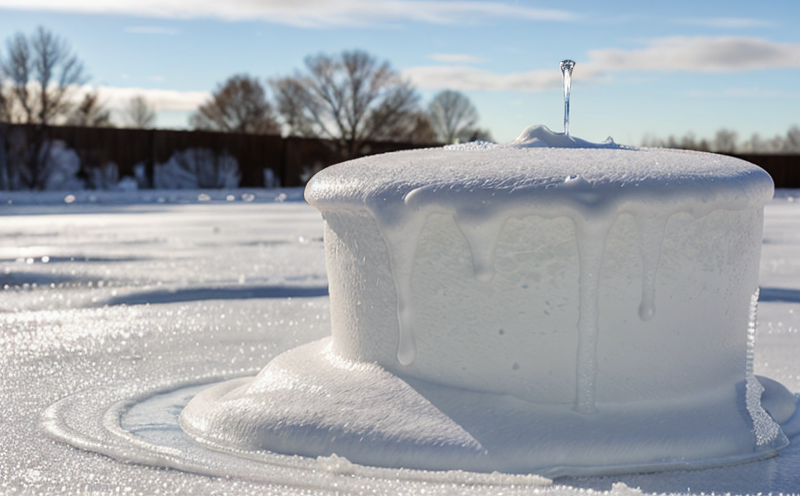RTCA DO-160 Section 24 Icing Condition Environmental Testing
The RTCA DO-160 standard is a critical document that outlines environmental testing requirements to ensure that electronic equipment used in the aviation industry can withstand the rigors of aerospace environments. Specifically, Section 24 of RTCA DO-160 focuses on icing conditions, which are particularly challenging due to their unpredictability and potential for significant impact on aircraft performance.
Icing conditions present unique challenges that must be addressed during testing to ensure the reliability and safety of electronic equipment. The ambient temperature, humidity levels, and ice formation dynamics all contribute to a complex set of environmental factors. This section addresses how to simulate these conditions in a laboratory setting accurately replicating real-world scenarios.
The tests conducted under this standard are designed to evaluate the performance of electronic components when exposed to icing conditions. These include both pre-icing (prior to takeoff) and in-flight icing conditions, which can be particularly severe at high altitudes where temperatures drop below freezing. The goal is not only to ensure that equipment functions correctly but also to verify its durability and resistance against potential damage.
Given the critical nature of electronic systems within aircraft, any failure could have catastrophic consequences. Therefore, thorough testing becomes essential before deployment in operational environments. By adhering strictly to RTCA DO-160 Section 24 guidelines, manufacturers can demonstrate compliance with industry standards while also providing assurance that their products will perform reliably under expected conditions.
This type of testing is crucial for several reasons:
- To ensure product reliability and safety
- To identify potential weaknesses early in the development process
- To meet regulatory requirements set forth by aviation authorities worldwide
- To gain competitive advantage through superior quality assurance practices
The testing procedure involves exposing electronic components to various levels of icing conditions, including but not limited to:
- Static icing environments
- In-flight icing scenarios
- Pre-landing icing conditions
To achieve accurate results, the laboratory must employ sophisticated equipment capable of simulating these complex environmental factors. This includes specialized chambers that can control temperature and humidity levels precisely, as well as controlled spray systems for generating ice crystals or frost formations.
The testing process typically begins with careful preparation of the specimens to be tested. This involves selecting representative samples based on design specifications and ensuring they are in optimal condition prior to exposure. During the actual test run, continuous monitoring ensures that environmental parameters remain within specified limits throughout the duration of each phase.
Upon completion of the tests, detailed reports are generated summarizing all observations made during the process. These documents serve as valuable resources for quality assurance teams and provide evidence supporting compliance with relevant standards.
Scope and Methodology
| Test Parameter | Description |
|---|---|
| Ambient Temperature Range | -40°C to +60°C |
| Relative Humidity Levels | 25% RH to 85% RH |
| Icing Conditions | Static icing and in-flight icing scenarios |
| Duration of Exposure | Up to 16 hours for each condition tested |
| Specimen Preparation | Selecting representative samples based on design specifications |
| Monitoring Equipment | Specialized chambers capable of controlling temperature and humidity levels |
The scope encompasses not only the technical aspects of replicating icing conditions but also includes considerations for environmental factors such as altitude, airspeed, and turbulence. Understanding these variables is crucial in accurately simulating real-world situations where electronic equipment may encounter ice formation.
Methodology involves several key steps:
- Selecting appropriate specimens
- Calibrating test chambers to specified temperatures and humidities
- Simulating various icing conditions through controlled spraying or other means
- Monitoring specimen performance during exposure periods
- Gathering data on observed behaviors
- Generating comprehensive reports summarizing findings
The methodologies employed in RTCA DO-160 Section 24 are designed to provide a comprehensive evaluation of electronic components' resilience against icing conditions. By following these rigorous procedures, laboratories can ensure that their tests accurately reflect the challenges faced by aviation electronics.
Why Choose This Test
- Mandatory compliance with industry standards and regulations
- Potential for early identification of design flaws or manufacturing issues
- Enhanced reliability and safety through thorough validation
- Competitive edge in demonstrating superior quality assurance practices
- Reduction in potential liabilities associated with equipment failures during flight operations
- Supports continuous improvement efforts within R&D departments
- Promotes sustainability by ensuring longevity of components without unnecessary replacements due to premature failure
The RTCA DO-160 Section 24 icing condition environmental testing provides several advantages over other types of tests:
- It ensures that equipment meets stringent standards required for aviation applications.
- It helps manufacturers identify potential weaknesses in their designs early on, allowing them to make necessary adjustments before production begins.
- It offers a competitive advantage by demonstrating superior quality assurance practices to customers and partners.
In addition to these benefits, choosing this test can help reduce the risk of equipment failure during critical flight operations. This is particularly important given the high stakes involved in aviation safety. By adhering strictly to RTCA DO-160 Section 24 guidelines, manufacturers can ensure that their products are reliable and safe under expected conditions.
Environmental and Sustainability Contributions
The importance of environmental testing extends beyond mere compliance; it plays a vital role in promoting sustainability within the aerospace industry. By ensuring that electronic components are robust enough to withstand harsh weather conditions, manufacturers contribute positively towards reducing waste associated with premature failures.
In addition to enhancing reliability and safety, RTCA DO-160 Section 24 testing helps promote sustainable practices by encouraging continuous improvement efforts aimed at making products more durable and efficient. This contributes to longer lifecycles for components, thereby minimizing the need for frequent replacements and disposal of old parts.
The rigorous nature of these tests also ensures that only high-quality materials are used in manufacturing processes, further supporting eco-friendly initiatives within the industry. Ultimately, by prioritizing environmental considerations during product development stages, manufacturers can play an active role in fostering a more sustainable future for aviation technology.





